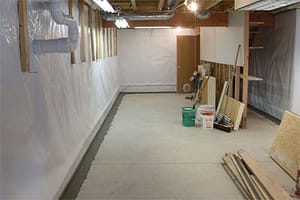Some Known Details About Best Basement Waterproofing
Some Known Details About Best Basement Waterproofing
Blog Article
The Ultimate Guide To Best Basement Waterproofing
Table of ContentsHow Best Basement Waterproofing can Save You Time, Stress, and Money.Some Ideas on Best Basement Waterproofing You Should KnowSome Of Best Basement WaterproofingBest Basement Waterproofing - An OverviewBest Basement Waterproofing for Dummies
uses excavation strategies toward the base of the structure's structure. includes removing moisture after it has actually gotten in the basement. AdvantaClean's experienced experts and specialists will locate the water source. If wall or piece fractures are present, we will certainly inject polyurethane and epoxies right into the splits and secure the concession, stopping additional wetness from going into.Proper grading around the home to direct wetness far from the framework. Putting up, repairing, or cleaning gutters and downspouts. Interior or outside waterproofing with filler, sealant, and/or water resistant paint. Setting up cellar ventilation systems, conditioning systems, or cellar dehumidifier systems to get water out of your cellar. Choosing AdvantaClean's basement waterproofing services is an effective means to deal with wetness and prevent mold from jeopardizing the structure of your home and the health of your family members.
If there's condensation on the exterior of the foil, you have high humidity in your cellar. If the aluminum foil has condensation on the inside surface (following to the wall surface), the soil around your home might be naturally damp from a high water table or inadequate soil drain.
You can waterproof just your indoor walls, which may address the issue. Once they dry out, they adhere permanently to concrete and masonry wall surfaces.
Little Known Questions About Best Basement Waterproofing.
Concrete waterproof layers can't be used to formerly painted surfaces; check the tag. Recognized as densifiers, they are suitable just for wall surfaces that haven't been painted or sealed.
But you comb, roll, or spray it on a lot more heavily one gallon covers just 75 square feet, not the 300 square feet regular with conventional paint. Water resistant paint is fine for DIY application. You can use it over repainted surface areas, and paint over it once it's cured (one gallon costs $37).
It can set you back $10,000 to $15,000, depending on the work required. Exterior waterproofing includes excavating all around your house to the full depth of the structure wall surfaces, then setting up a waterproof coating or membrane layer topped by drain panels. The panels offer an easy course for water to stream to an outside French drainpipe at the base of your structure.
Unknown Facts About Best Basement Waterproofing
A basement without waterproofing is kind of like that. Your basement does not desire to go through a downpour without proper defense just as much as you don't want to.
Outside waterproofing is a waterproofing approach that entails securing your home from the exterior. It's sort of like a moat around a castle. It includes excavating a trench around your whole home down to the foundation (regarding 8 to 10 feet down). The foundation walls are then cleaned up, sealed, and covered with a water resistant membrane layer or sealant.

Things about Best Basement Waterproofing
It's a more engaged process that calls for excavating up your backyard, which is costly and taxing. Outside waterproofing includes getting rid of every little thing surrounding your house, consisting of decks, driveways, walkways, landscape design, air conditioning units, decks, and more. If any one of the work was done inaccurately and water is continue reading this still entering your basement, there isn't much you can do to fix or fix it.
Inside basement waterproofing entails waterproofing from the inside. Any water that leakages into your basement is redirected before it touches your flooring. It's kind of like wearing a raincoat under your clothes. It includes 2 points: a water drainage track and a sump pump. It works by sealing the inside of your basement wall surfaces and floors so water that attempts to go into is funnelled out via a sump pump.
It's a reliable method to water-proof your basement. The downside of indoor cellar waterproofing mostly concerns the installment process. This method needs stored things, furnishings, and integrated shelving or cabinets to be a fantastic read relocated from touching the cellar walls. And during setup, your cellar can't be utilized. The largest distinction between both techniques is this: Exterior waterproofing is a preventative remedy and interior waterproofing is a restorative option.
All about Best Basement Waterproofing
Finally, outside and indoor basement waterproofing are both effective approaches of protecting your home from water damages. Outside waterproofing produces an obstacle that protects against water from entering your home, while indoor waterproofing redirects water that does enter your home. And it's crucial to note that exterior waterproofing is a pricey and turbulent installment process when contrasted to indoor waterproofing.
Whichever approach you pick, make certain you select a trustworthy and credible professional for the work. If you have any kind of questions concerning basement waterproofing, please reach out to us.
You can complete our kind below. Best Basement Waterproofing, begin a chat in the bottom right-hand edge, or call us at 1-800-827-0702
Report this page